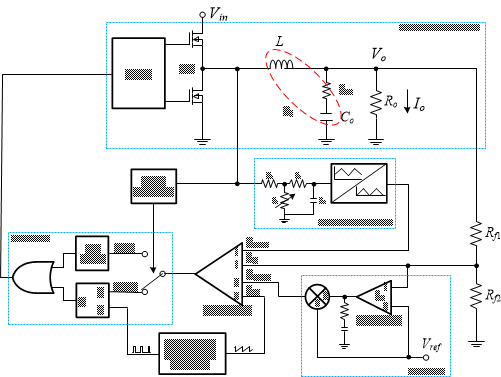SLYY205A March 2021 – October 2022 TPS562211 , TPS562212 , TPS562231 , TPS563211 , TPS563212 , TPS563231 , TPS56339
AECM control benefits
AECM is a new topology based on a fixed frequency modulator with emulated current information for the loop control, combining the fixed frequency of PCM control and the fast load-transient response of the D-CAP2 control topology. The key features and benefits of AECM include:
- True fixed-frequency modulation that can simplify EMI filter design and make it easy to achieve high-frequency modulation such as 2.1 MHz.
- An emulated ramp-generator circuit with smart loop-bandwidth control that can adjust the DC gain smartly, supporting wide-output and high-duty-cycle applications with good load transient performance.
It is possible to simplify AECM control for a buck converter, as shown in Figure 9. There are two basic operation modes, PWM mode and PFM mode, selectable by the mode-detection block. The integrator in the voltage loop can improve output-voltage accuracy issues. The integrated oscillator generates the fixed clock. Implementing slope compensation in the modulator avoids subharmonic oscillation when the duty cycle is higher than 50% in PWM mode. The emulated ramp generator with the smart loop-bandwidth control circuit can adjust the DC gain to achieve high bandwidth over all output rails. And even though there is an integrator, unlike PCM control, the integrator in AECM control can improve output-voltage accuracy with no direct impact on loop response speed.
 Figure 7 AECM control block
diagram.
Figure 7 AECM control block
diagram.